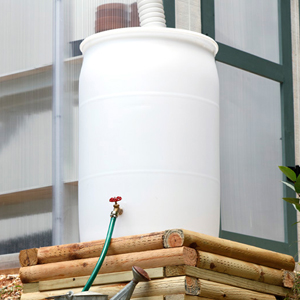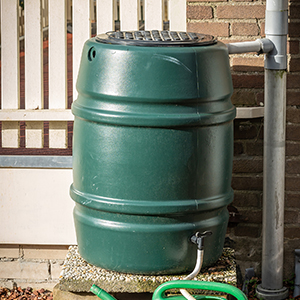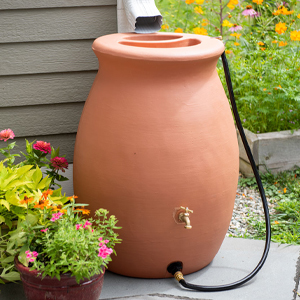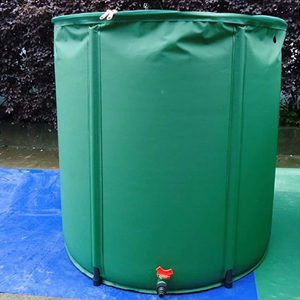What Is a Rain Barrel?
A rain barrel collects and stores rainwater from your rooftop to use later for things like lawn and garden watering and car and window washing. As these pictures show, rain barrels sit under a down spout and are usually installed on the ground next to a building.
Rain barrels come in a wide variety of materials, designs, and colors. Common sizes for residential use are 55 gallons and 90 gallons. You can purchase or make your own rain barrel.
All rain barrels serve the same purpose — to collect rainwater and decrease the amount of stormwater runoff that leaves your property.




Where to Purchase a Rain Barrel
(This list is for informational/educational purposes only and does not indicate an endorsement of any company.)
Rain barrels can be purchased locally from garden supply and hardware stores and online from many different companies. A Google search of “rain barrels” will provide many options. Below are just a few sources:
Making Your Own Rain Barrel:
(This list is for informational/educational purposes only and does not indicate an endorsement or recommendation of any how-to video.)
If you’re handy you might want to make your own rain barrel. Do-it-yourself rain barrels are inexpensive and easy to build and install.
Penn State Three Minute Gardener – “Rain Barrels”
HGTV – “How to Build a Rain Barrel”
PA Horticultural Society – “Fast and Easy Rain Barrel For Your Garden”
Why Use a Rain Barrel?
- Lawn and garden watering make up nearly 40% of total household water use during the summer. A rain barrel will save most homeowners about 1,300 gallons of water during the peak summer months, which means lower water and sewer bills. A rain barrel is an easy way for you to have a consistent, FREE supply of water for outdoor use.
- Rain barrels also benefit the environment by reducing the amount of stormwater that flows across the landscape into our waterways and storm sewers. This reduces water pollution because stormwater runoff can contain pollutants like sediment, oil, grease, bacteria, and nutrients.
- Using stored rainwater on your garden or lawn instead of directing rooftop runoff to the storm drain network helps recharge groundwater naturally.
- Many gardeners find that their plants perform better with rainwater than tap water as it is chlorine-free.
- Showcasing a rain barrel in your yard promotes the importance of conserving our water resources.
How Can I Use The Water From A Rain Barrel?
- Water your garden. However, don’t use the water for drinking, cooking, or bathing!
- Water potted plants.
- Window washing.
- Wash your car or bike.
- Clean work boots and tools.
- Water the lawn.
Keeping Mosquitoes Out of Your Rain Barrel
- Rain barrels are designed to keep bugs and debris out of the water, but make sure you have a mosquito-proof screen to seal and cover your rain barrel. Mosquito-proof screen is a very fine mesh, usually 1/16 of an inch. If the barrel is covered, this will reduce the likelihood of mosquitoes becoming a problem.
- Be sure to remove the water that pools at the top of the barrel at least once or twice a week.
- Make sure water does not pool on the ground around your rain barrel.
- Regularly inspect your rain barrel system, checking for cracks or leaks.
- If water stays in your rain barrel more than five days, you could consider any of the following options for eliminating mosquitoes:
- Adding one tablespoon of liquid dish soap once a week or after each storm. Because soap breaks the surface tension of the water, mosquitoes will drown before they get a chance to lay their eggs. Be sure to use eco-friendly liquid soap to prevent additional pollution and prevent damage to your plants if you use water from the barrel for irrigation.
- Adding MosquitoDunks once a month or as needed. Dunks are made of a bacteria that kills mosquito larvae. They dissolve slowly, releasing the bacteria for approximately 30 days.
- Adding 1/4 cup of vegetable oil once a week or after each storm. The oil floats on the top of the water in the rain barrel and will suffocate the mosquito larvae, should mosquitoes lay eggs in the water.
Other Considerations
- When installing a rain barrel you will need to choose a location near a downspout. The ground should be level. For a rain barrel to drain well, it needs to be elevated. Paver blocks can be added as a base to raise the barrel off the ground. This will give the water an extra push from gravity and will give you enough room so that you can place a watering can or bucket beneath the spigot.
- A roof collects a lot of water. A roof that is 1,000 sq. ft. in size collects about 625 gallons of water for every inch of rain that falls. Use this rainwater collection calculator to determine how much water the roof of your house might yield. Depending on the size of your roof, it might be worthwhile to connect a series of barrels to collect more water.
- You’ll want to have a debris screen to filter out leaves, pine needles and other debris. If you don’t filter out this debris, it will accumulate at the bottom of the tank and may clog up the outflow. A well-fitting lid is also important to protect children and prevent mosquitoes from breeding in the water.
- Disconnect your rain barrel during the winter to avoid freezing and breaking of the barrel and its valves. Drain the system and connecting hoses by leaving the drain of the barrel open or turn the barrel over to drain and store the barrel with hoses in a protected area.
Don’t Forget to Winterize Your Rain Barrel
To extend the life of your rain barrel, you should plan to winterize it. Over the winter months, water left in a rain barrel will freeze, expand, and crack the rain barrel. Winterizing is easy…just follow these three simple steps:
- Disconnect the downspout from the rain barrel, and re-connect a downspout extension to the main downspout to funnel water away from the foundation of the house.
- Empty the rain barrel.
- Flip the rain barrel upside-down and store it outside, or, if you have room, move the rain barrel into a garage or basement.